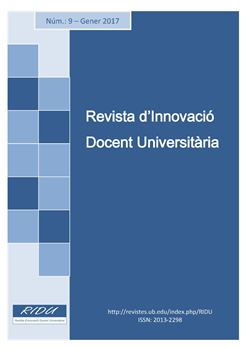Flipped classroom and team-based learning: two methodologies to stimulate the repeater student
DOI:
https://doi.org/10.1344/RIDU2017.9.1Keywords:
Teaching innovation, Flipped classroom, Team based learningAbstract
This paper proposes the use of flipped classroom and team-based learning methodologies to improve students’ learning attitudes in large groups of students retaking a subject —the so-called Groups of Intensive Study (GIS). GISs are designed for those students who repeat a subject in one of the degrees offered by the Faculty of Economics and Business at the Universitat de Barcelona. We have implemented both methodologies in three GISs taught by the Economic Theory section of the Department of Economics of the University of Barcelona. The results obtained in the academic years 2013-2014 and 2014-2015 reveal significant improvements in the performance of the students who followed these methodologies.References
Baepler, P. (2014) It's not about seat time: Blending, flipping, and efficiency in active learning classrooms. Computers and Education, 78, pp. 227-236.
Bergmann, J., Sams, A. (2012) Flip your classroom: Reach every student in every class every day. Washington, D.C.: International Society for Technology in Education.
Berrett, D. (2012) How ‘flipping’ the classroom can improve the traditional lecture. The Chronicle of Higher Education. Disponible en: http://chronicle.com/article/How-Flipping-the-Classroom/130857/.
Chung, K. (2014) Professors ‘flip’ classrooms, enhance learning. Daily Tar Heel. Disponible en: http://www.dailytarheel.com/article/2014/01/flipped-classrooms-0108.
Crouch, C., Mazur, E. (2001) Peer Instruction: Ten Years of Experience and Results. American Journal of Physics, 69, pp. 970-977.
Deslauriers, L., Schelew, E., Wieman, C. (2011) Improved Learning in a Large-Enrollment Physics Class. Science, 332, pp. 862-864.
Hong, T., Pham, T. (2013) Using group projects as a strategy to increase cooperation among low - and high-achieving students. Higher Education Research and Development, 32, pp. 993-1006.
Jackson, M.W., Prosser, M.T. (1989) Less lecturing, more learning. Studies in Higher Education, 14, pp. 55-68.
King, A. (1993). From sage on the stage to guide on the side. College teaching, 41, pp. 30-35.
Knight, J.K., Wood, W.B. (2005) Teaching More by Lecturing Less. Cell Biology Education, 4, pp. 298-310.
Kruger, J., Dunning, D. (1999) Unskilled and unaware of it: How difficulties in recognizing one’s own incompetence lead to inflated self-assessments. Journal of Personality and Social Psychology, 77, pp. 1121-1134.
Lage, M.J., Platt, G.T., Treglia, M. (2000) Inverting the classroom: A gateway to creating an inclusive learning environment. The Journal of Economic Education, 31, pp. 30-43.
Mazur, E. (1997) Peer Instruction: A User's Manual Series in Educational Innovation. Prentice Hall, Upper Saddle River, NJ.
McLaughlin, J.C. (2013) Pharmacy student engagement, performance, and perception in a flipped satellite classroom. American Journal of Pharmaceutical Education, 77, pp. 1-8.
Michaelsen, L.K., Knight, A.B., Fink, L.D. (2004) Team-Based Learning: A Transformative Use of Small Groups in College Teaching. Sterling, Va. Stylus.
Millis, B. J., Cottell, P.G. (1998) Cooperative Learning for Higher Education Faculty. Oryx Press, Phoenix, Ariz.
Missildine, K., Fountain, R., Summers, L., Gosselin, K. (2013) Flipping the classroom to improve student performance and satisfaction. Journal of Nursing Education, 52, pp. 597- 599.
Nordberg, D. (2008) Group projects: More learning? Less fair? A conundrum in assessing postgraduate business education. Assessment and Evaluation in Higher Education, 33, pp. 481-492.
Opdecam, E., Everaert, P., Van Keer, H. (2014) Preferences for Team Learning and Lecture-Based Learning Among First-Year Undergraduate Accounting Students. Research in Higher Education, 55, pp. 400-432.
Park, E.L., Choi, B.K. (2014) Transformation of classroom spaces: traditional versus active learning classroom in colleges. Higher Education, 68, pp. 749-771.
Pennebaker, J.W., Gosling, S.D., Ferrell, J.D. (2013) Daily Online Testing in Large Classes: Boosting College Performance while Reducing Achievement Gaps. PloS ONE, 8(11), e79774.
Prieto, A., Díaz, D., Montserrat, J., Reyes, E. (2014) Experiencias de aplicación de estrategias de gamificación a entornos de aprendizaje universitario. ReVisión, 7, pp. 76-92.
Roediger, H.L. III, Putnam, A.L., Smith, M.A. (2011) Ten benefits of testing and their applications to educational practice. Edited by: Mestre, J.P., Ross, B.H. Psychology of Learning and Motivation: Cognition in Education,Book Series: Psychology of Learning and Motivation, Volumen 55, pp. 1-36.
Shah, S.Z.A. (2013) The use of group activities in developing personal transferable skills. Innovations in Education and Teaching International, 50, pp. 297-307.
Strayer, J. (2012) How learning in an inverted classroom influences cooperation, innovation and task orientation. Learning Environments, 15, pp. 171-193.
Wilson, S.G. (2013) The flipped classroom: A method to address the challenges of an undergraduate statistics course. Teaching of Psychology, 40, pp. 193-199.
Yamarik, S. (2007) Does Cooperative Learning Improve Student Learning Outcomes? Journal of Economic Education, 38, pp. 259-277.
Downloads
Published
Issue
Section
License
Authors whishing to publish in this journal agree to the following conditions:
- The author or author retain copyright and grants the journal the right of first publication of the paper.
- The texts will be published under license "Reconocimiento Creative Commons 4.0 España", which allows to share, distribute, reproduce and the public communication of the paper, as long as the name of the author or authors and the journal are clearly stated.







